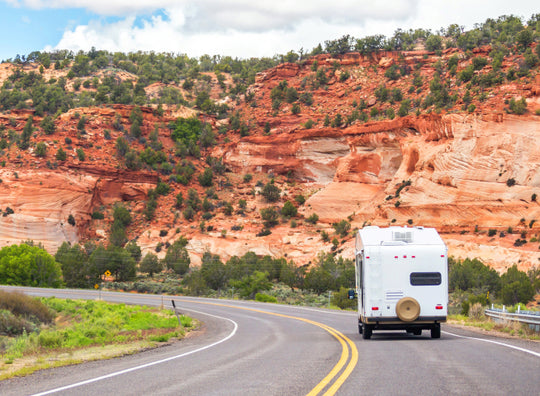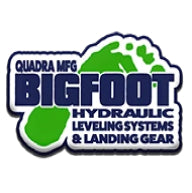Written by the Getaway Couple Rae & Jason
RV stabilizer jacks have a significant job when it comes to your RV. How you use them is very important. It can cause problems or require you to do some repairs when misused. If you want to avoid issues and unnecessary repairs, this article is for you. Let’s get started!
What Are RV Stabilizer Jacks?
RV stabilizer jacks extend from the frame of an RV to the ground to reduce the movement felt in the RV. These jacks can’t handle heavy loads, and you’ll get the best results the less you need to extend them. Many RVers utilize wood blocks or plastic leveling blocks to help reduce the amount of extension required for each stabilizer jack.

What Is the Difference Between Stabilizing Jacks and Leveling Jacks?
Assuming stabilizing jacks are the same as leveling jacks is one common mistake many RVers make. While they’re both jacks, they serve two different purposes. Using them outside of their intended purpose can damage your jacks and RV.
Stabilizing jacks should only support your RV. They’re not able to lift heavy loads or make adjustments to your RV. They support portions of your RV to absorb the shifting you might feel as you and others move around inside your RV. They can’t eliminate all movement, but they make a noticeable difference when used correctly.
On the other hand, leveling jacks do exactly what their name implies. These jacks are specifically for leveling your RV from side to side or front to back. Some units with auto-leveling systems will lower the jacks in a specific sequence to level the RV. Under ideal circumstances, this can result in an effortless and stress-free RV setup.
Can You Level a Camper With Stabilizer Jacks?
You should never use your stabilizer jacks to level a camper. Repeat after us, “I will never use my stabilizer jacks to level my RV.” The intended purpose of stabilizer jacks is to stabilize your rig. You’ll likely find multiple warning labels telling you not to overload your jacks or lift your RV. When you use your stabilizer jacks to lift your RV, you risk damaging not only the jacks but also your RV’s frame.
Types of RV Stabilizer Jacks
There are several types. If you’re looking to add or upgrade the jacks on your RV, you’ll want to know the differences. Let’s take a look.
Scissor Jacks
You often see scissor jacks on travel trailers and some older fifth wheels. Manufacturers typically install these on their RVs as they’re cheap, simple, and do a great job.
Most scissor jacks require manual work from the owner to raise and lower them. There’s typically a bolt you tighten and loosen by using a ratchet or drill. Avoid over-tightening them, or you’ll risk putting too much weight on them.

Drop-Down Jacks
Drop-down jacks are another type of RV stabilizer jack. These mount to the frame of your RV and retract up into themselves when not in use. You can often find these in manual and automatic options.
Some higher-end systems will use the heavy-duty drop-down jacks as a part of the auto-leveling system. At the press of a button, the RV can level and stabilize itself. However, not all drop-down jacks can handle lifting a heavy RV. So make sure you avoid overloading your jacks.
Screw Jacks
Screw jacks are a very cost-effective method for stabilizing your RV. Their aluminum construction makes them lightweight but strong enough to hold upwards of 6,000 lbs. Because these jacks do not mount or secure to the RV, you can easily adjust them and move them around your camper as needed. For less than $50, you can get a set of four jacks to put on each corner of your RV.
Full-Width Double Stabilizers
If you want to simplify setting up and stabilizing your RV, a set of full-width double stabilizers will do the trick! These stabilizers typically provide optimal support for your rig and can easily adjust to accommodate uneven camping surfaces.
An added benefit of these jacks is that some can lift upwards of 6,000 lbs. These jacks are strong enough to make it easy to level your rig, too. Some jack manufacturers can use them to install an after-market leveling system on trailers that didn’t come with such a system.
Where Do Stabilizer Jacks Go on an RV?
You’ll typically find stabilizer jacks near all four corners of an RV. However, some longer RVs have additional stabilizer jacks located in the middle. These further enhance the stability and provide a more comfortable experience when using your RV.

How Tight Should Travel Trailer Stabilizer Jacks Be?
You want to make sure your stabilizer jacks are snug but not too snug. It’s best to get to the point where there’s tension on them, but not too much that you’re lifting your RV. It can be very easy to over-tighten your stabilizer jacks, especially if you’re using a drill to do the job.
Should You Put Blocks Under Stabilizer Jacks?
Yes, you should always put blocks under your stabilizer jacks. This not only helps protect your jacks but the campsite as well. You may even come across some campgrounds or RV parks that require a barrier between your landing gear and the campsite surface.
Many choose to use SnapPad products for their stabilizer jacks for massive convenience. You don’t have to worry about wooden or plastic blocks taking up storage and removing one step in the setup and tear down process.

Now You Know
Stabilizer jacks are among the most underappreciated features many RVers take for granted. All it takes is using your RV for a few hours without them, especially if you have energetic kids. They drastically reduce the bounce and movement you feel inside your RV. If you’re tired of feeling like you’re on a cruise ship at sea, it might be time to upgrade or invest in stabilizer jacks for your RV.










